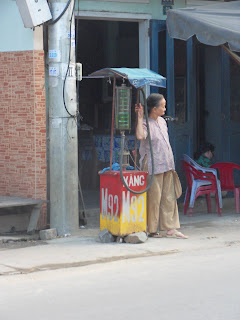Our guide took us on quite a comprehensive tour of the old town, starting with the Chinese meeting house/temple. The meeting house is still used now and was built by the substantial Chinese community that had settled in Hoi An after a change in dynasties in China caused many Fujian people to leave China. It used to be a place exclusively for the Chinese, but now due mainly to intermarriage, the meeting place is open to everyone. Many people come here to light incense and to pray for their wishes to come true; the incense burns for three weeks.
The Japanese influence in Hoi An can be seen by the Japanese covered bridge. This bridge was built by the Japanese between their quarter and the Chinese quarter so as to unite the two and make trade more easy. It is also the only bridge in Vietnam to be covered. One side of the bridge is guarded by two monkeys and the other by two dogs - the reason for this being that the building of the bridge started in the year of the monkey and ended in the year of the dog. Since the bridge was covered, the Chinese then built a small temple in the middle of the bridge (this was done without the Japanese knowing, whilst they had all returned to Japan in respect of the Emperor's death) - sneaky and quite funny.
 Another thing Hoi An is famous for are its handicrafts and tailors. Walking around Hoi An it is impossible to miss the many tailors offering to make you dresses, suits, shirts skirts, shoes and anything else that you may want. Some clearly are better than others, but most will have your order ready by the next day. Many shops also sell locally made handicrafts.
Another thing Hoi An is famous for are its handicrafts and tailors. Walking around Hoi An it is impossible to miss the many tailors offering to make you dresses, suits, shirts skirts, shoes and anything else that you may want. Some clearly are better than others, but most will have your order ready by the next day. Many shops also sell locally made handicrafts. We went to one of these shops, where you could watch the women stitching pictures from photographs - this really was amazing, the detail with which this is done is impressive. The same place also weaves material and straw mats. In addition to this, they have a silk worm farm - the worms have to be fed every three hours, and trust me it's not little!
For dinner we went to find a local place, so we walked in the direction away from the old town, where we eventually came across some locals drinking beer on a pavement cafe. They told us where we could get some good food, which ended up being where we ate the next day also. It was a small eatery down an alleyway that was pretty much closed when we got there - but they still served us. One of the women could speak really good English which, it turned out, was due to the fact that she was married to an Australian. On our way back to the hotel we then stopped by the pavement cafe and had a couple of beers with the locals - one of which was a boat driver, and he had to get up in the morning to drive a boat; my theory is that the only way for them to be able to deal with noisy obnoxious tourists is to just get so drunk the night before that they're still drunk when on the job! But in all seriousness, they were all very friendly and as with most businesses here it's family run, so the kids and the grandmother were also there and all smiley and friendly. Whem we walked past the next day they also waved at us and said hi.
I very much enjoy meeting locals who are not out to get something from you - it is such a different experience from talking to those that are directly involved with the tourists or talking to you in their tourist haggling capacity. The people are just friendly and interested and living their lives allowing you to be part of it.





No comments:
Post a Comment